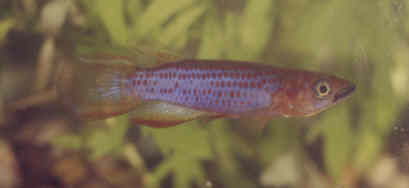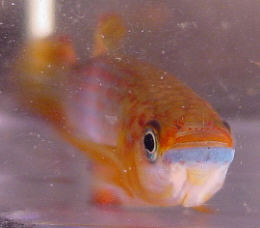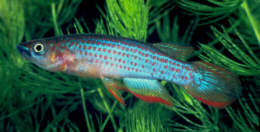Epiplatys lamottei Daget 1954

E.lamottei I took in 1982
| Meaning of Name |
After Pr. M. Lamotte who collected the species. |
||||||
| First Description |
Daget J. 1954. Les Poissons du Niger supérieur. Mémoires de l'Institut Français d'Afrique Noire (IFAN) 36: p 317-318, figure 20. |
||||||
| Size |
Males 7 cm, females 6 cm. |
||||||
| Meristics |
|
||||||
| Karyotype |
n = 24 (28) |
||||||
| Sub-Genus |
Epiplatys |
||||||
| Group |
fasciolatus |
||||||
| Synonyms |
|
||||||
Populations
|
|
||||||
| Type Locality |
Simandou, southestern Guinea. |
||||||
| Distribution |
Southestern corner of Guinea extending into northern Liberia. They inhabit the upper Niger River (Guinea), the upper Lofa, Saint John & Saint Paul River drainage systems (Guinea & Liberia). http://homepage.uibk.ac.at/homepage/c102/c102mr/epiplaty/lamottei.htm |
||||||
| Habitat |
Small streams & brooks in heavy shade. Reported
to inhabit inaccessible root systems. Water measured in the habitat,
water temperature 21-22°C, pH 7·5-7·8 DH 1-1·5.
It is likely this alkaline pH may change to acid during seasonal changes. |
||||||
| Distinguishing Characteristics |
 E.lamottei showing dark area under bottom lip. Photo courtesy of Allen Boatman. |
||||||
| Colour/Pattern Variability | Low | ||||||
| History |
Daget described this species in 1954 as Epiplatys
fasciolatus lamottei from 22 specimens collected in the area
of a range of small hills situated between the Milo & Sankarani
Rivers, Upper Niger drainage. The point of collection of the type specimens
being Simandou. No data available as to who collected them. In 1964 Herold Olsen collected this species ( 7 males & 6 females ) near N'Zérégoré, High Guinée. This location is 140 km from the type locality. Scheel considered these to be a distinct species. In 1971 Roloff reported another location in north west Liberia 70kms from N'Zérégoré near the frontier with Guinea. |
||||||
| Breeding Notes |
I have kept this species on a number of occasions
in water temperature 75-80°F, 100% rainwater, pH 6, DH less than
1° & found them fairly easy, laying eggs in floating or bottom
mops (in the thickest part) mainly which were taken out & incubated
in a separate container. I found better results from using rainwater
with a little salt. Some breeders I talked to found salt to be lethal.
The tank was placed in full daylight with a good growth of floating
plants. Water incubation takes 12-15 days. Fry take newly hatched brine
shrimp as a first food. Growth rate of the young fish is quite fast
with sexual maturity being attained around 5-6 months. We have kept populations which breed in hard water. These were bought at auction without any population mark. It would appear that this (& perhaps other Epiplatys species) are very different in their ways of reproduction. It could be the manner in which they were raised as these were obtained through open auction. |
||||||
| Diameter of Egg | Fairly large | ||||||
| Remarks |
|



